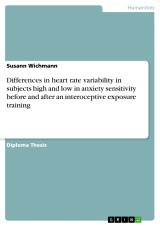Details

Differences in heart rate variability in subjects high and low in anxiety sensitivity before and after an interoceptive exposure training
1. Auflage
|
29,99 € |
|
| Verlag: | Grin Verlag |
| Format: | |
| Veröffentl.: | 18.06.2019 |
| ISBN/EAN: | 9783668960909 |
| Sprache: | englisch |
| Anzahl Seiten: | 77 |
Dieses eBook erhalten Sie ohne Kopierschutz.
Beschreibungen
Diploma Thesis from the year 2008 in the subject Psychology - Clinic and Health Psychology, Abnormal Psychology, grade: 1,3, Dresden Technical University, language: English, abstract: Reduced heart rate variability (HRV) has proved to be an independent risk factor for cardiac emergencies. The present study aimed to evaluate differences in HRV in healthy volunteers high or low in anxiety sensitivity (AS) and potential changes in HRV following an interoceptive exposure (IE) training. We aimed to identify subject features that are associated with potential changes in HRV. Methods: Data were obtained in five subjects high and five subjects low in AS (aged 19 to 23).
ECG recordings were conducted in supine position in a mock scanner environment during three experimental conditions. Recordings were repeated after three to seven days of IE training. The square root of successive R-R- interval differences (RMSSD) was calculated for HRV assessment. Potential correlations between subject features and change in HRV were tested with Spearman’s rank correlation. Results: No significant HRV differences between subjects high and low in AS in any of the experimental conditions were observed, neither before nor after the IE training. On a descriptive level, subjects high in AS showed lowered HRV compared to subjects low in AS before IE. After IE, subjects low in AS demonstrated increased HRV, while subjects high in AS showed decreased HRV measures. Correlation analyses revealed no significant associations.
Conclusion: Descriptive results indicate that there are AS-related differences in HRV, with subjects high in AS showing lowered HRV as hypothesized. Following IE, subjects low in AS showed an increase in HRV, while a decrease occurred in subjects high in AS. The mechanisms of IE require further investigation. If replicated in a larger sample and with adequate study design, IE could prove to lower individual risk for cardiac complications by increasing HRV. Future design implications are discussed.
ECG recordings were conducted in supine position in a mock scanner environment during three experimental conditions. Recordings were repeated after three to seven days of IE training. The square root of successive R-R- interval differences (RMSSD) was calculated for HRV assessment. Potential correlations between subject features and change in HRV were tested with Spearman’s rank correlation. Results: No significant HRV differences between subjects high and low in AS in any of the experimental conditions were observed, neither before nor after the IE training. On a descriptive level, subjects high in AS showed lowered HRV compared to subjects low in AS before IE. After IE, subjects low in AS demonstrated increased HRV, while subjects high in AS showed decreased HRV measures. Correlation analyses revealed no significant associations.
Conclusion: Descriptive results indicate that there are AS-related differences in HRV, with subjects high in AS showing lowered HRV as hypothesized. Following IE, subjects low in AS showed an increase in HRV, while a decrease occurred in subjects high in AS. The mechanisms of IE require further investigation. If replicated in a larger sample and with adequate study design, IE could prove to lower individual risk for cardiac complications by increasing HRV. Future design implications are discussed.

















